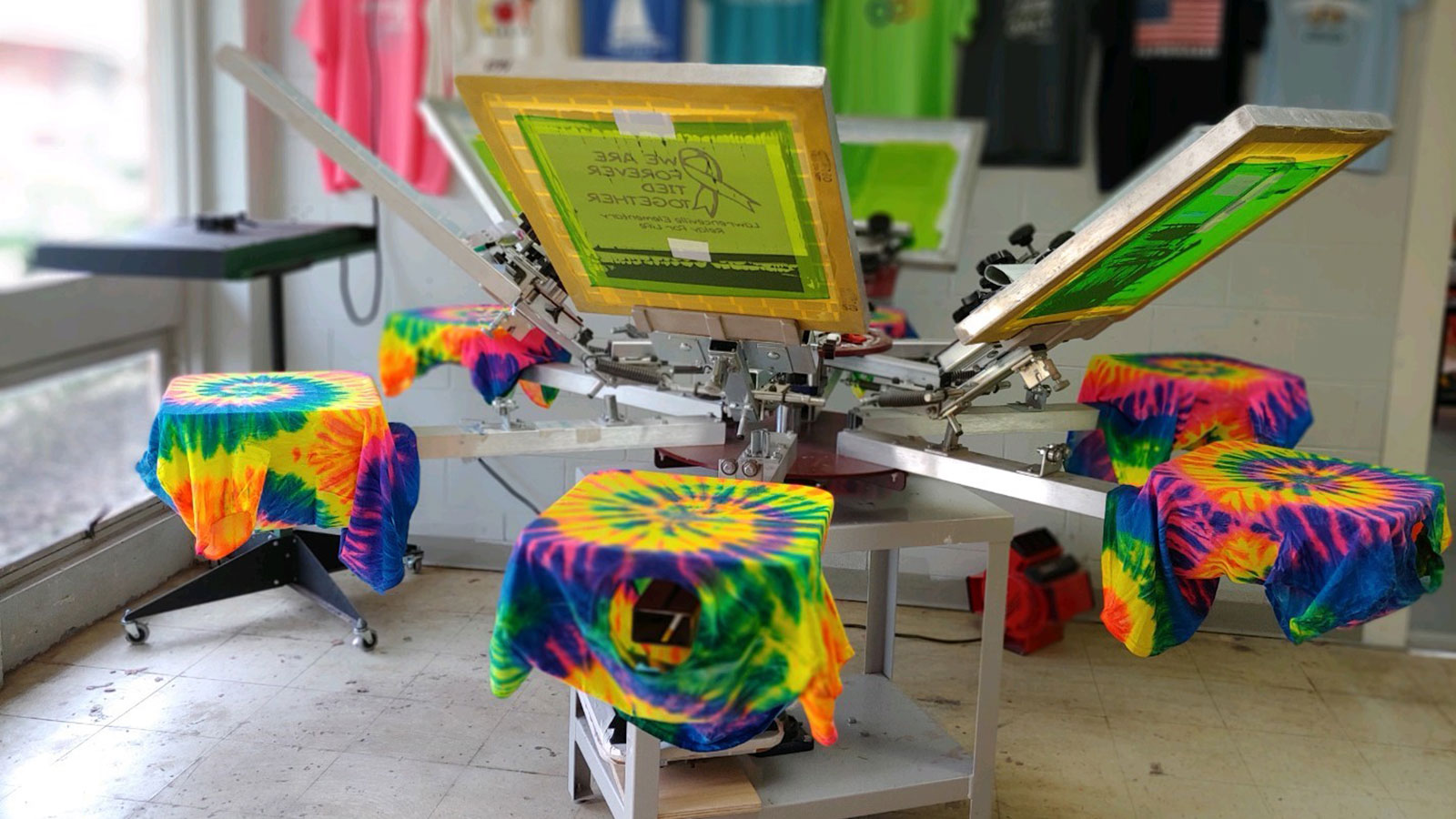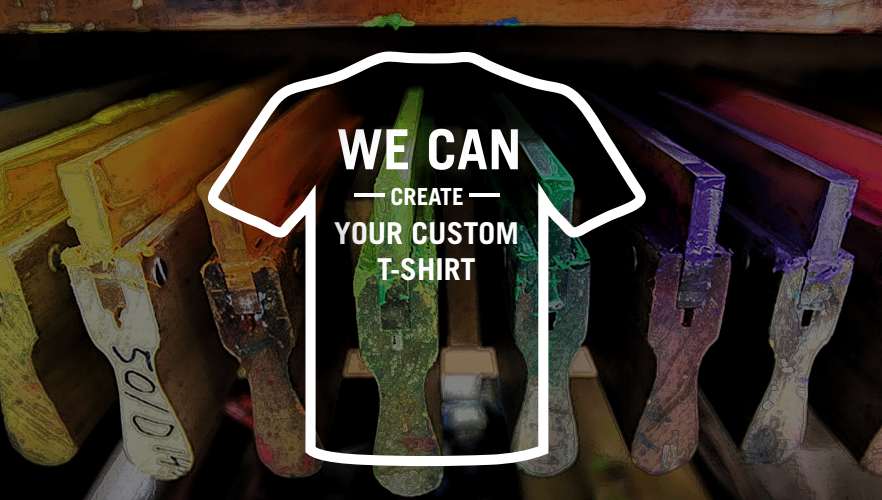Display Printing Uncovered: Every Little Thing You Need to Learn About T-Shirt and Garment Printing Strategies
Screen printing is a fascinating method that integrates art with method, using limitless opportunities for creative thinking. Prepared to discover the vital aspects that make screen printing an art form?
The Fundamentals of Display Printing: Exactly How It Works
When you plunge right into display printing, you'll discover it's both an art and a science. At its core, screen printing entails developing a stencil, or display, that allows ink to pass via just in specific areas.
Setting the display over the textile, then utilize a squeegee to push ink via the display onto the garment. Each step is necessary, and mastering them will boost your screen printing skills, changing easy garments right into special, expressive pieces.
Sorts Of Display Printing Strategies
Once you understand the essentials of display printing, it's time to explore the various methods that can raise your layouts. One prominent technique is traditional display printing, where ink is pressed with a stenciled screen. This technique is terrific for vibrant, dynamic colors. Then there's water-based ink printing, which provides a softer feeling and is eco-friendly, but it calls for a various technique to curing.
If you're intending for great details, think about discharge printing. This method eliminates dye from the material, leaving a soft, vintage appearance. One more alternative is plastisol printing, known for its sturdiness and vibrant shades, making it a preferred for lots of brand names. Experiment with halftone printing to produce slope results and elaborate designs. Each method has its one-of-a-kind charm, so do not hesitate to try them out to discover what matches your style best!
Crucial Devices for Screen Printing
To achieve magnificent results in screen printing, having the best devices is essential. You'll need a tough display printing framework, which holds the mesh that transfers your style onto the garment. Next, purchase premium mops; these are crucial for applying ink equally throughout the screen. You'll also require a good exposure unit to create your displays, as well as a washout cubicle for cleaning them after use. A trustworthy heat resource, like a conveyor clothes dryer or warmth press, is vital for healing your prints to ensure long life. Do not neglect an appropriate work space, equipped with tables and storage for your supplies. Lastly, safety equipment, such as handwear covers and masks, will keep you safe from chemicals and inks. With the right tools, you'll be well on your means to generating professional-quality prints.
Picking the Right Inks and Materials
When picking inks and products for screen printing, you require to consider the sort of ink that functions best for your project. Consider material compatibility to assure your styles look last and fantastic lengthy. Additionally, explore green ink alternatives to make your printing procedure much more sustainable.
Kinds Of Screen Inks
Choosing the appropriate screen ink is crucial for accomplishing vivid, resilient prints that satisfy your job's demands. There are several types of display inks to examine. Specialized inks, such as metallic or glow-in-the-dark, can add distinct effects to your styles.

Fabric Compatibility Considerations
Understanding material compatibility is crucial for attaining top notch display prints, particularly because various products respond uniquely to various inks. When picking inks, take into consideration the material kind-- cotton, polyester, or blends. For cotton, water-based inks work well, providing softness and breathability. Polyester, on the various other hand, typically calls for plastisol inks for much better adhesion and vibrant shades. You might require to utilize a combination of both kinds if you're publishing on blends. Always test your inks on example material to assure they stick correctly and maintain shade stability. Furthermore, bear in mind that textile weight and texture can influence the final outcome, so choosing the ideal ink and material combination is crucial for your project's success.
Eco-Friendly Ink Options
Environmentally friendly inks are coming to be a popular choice for display printers that wish to lessen their environmental influence while maintaining high quality. When choosing inks, consider water-based inks, which are much less unsafe and simpler to cleanse up contrasted to standard solvents. These inks bond well with fabrics, delivering lively results without poisonous chemicals. You might likewise check out eco-solvent inks that make use of fewer unpredictable organic substances (VOCs), making them a much safer choice for both your health and wellness and the earth.
In addition, look for inks made from renewable energies, such as soy or vegetable-based alternatives. By picking the appropriate inks and products, you'll not only produce magnificent layouts yet likewise add to a more sustainable printing process. Make the button, and your prints will show your commitment to the environment!
Preparing Your Design for Display Printing

File Layout Demands
To guarantee your style looks sharp and vibrant on fabric, you'll need to pay attention to file layout requirements for display printing. Start with vector documents like AI or EPS, as they can be scaled without losing high quality. If you make use of raster images, choose high-resolution documents, such as TIFF or PNG, preferably at 300 DPI. Prevent making use of JPEGs, as they can shed clearness when resized. Make sure your layout has a clear history to avoid undesirable white sides on your prints. Maintain shade modes in mind; CMYK is conventional for screen printing, so convert your RGB creates as necessary - screen printing kit. By following these guidelines, you'll establish your artwork up for a successful print.
Color Splitting Up Methods
Color separation is a necessary action in preparing your layout for screen printing, and grasping it can substantially improve your print top quality. You'll need to break your layout into private colors, as each shade calls for a separate display throughout printing. Start by identifying all the colors in your design and produce layers each. You can make use of software like Adobe Photoshop or Illustrator to isolate and separate colors successfully. Be certain to save each layer as a separate file, generally in a format like TIFF or PSD. This precision not only assures accurate shade depiction however additionally improves the printing process. By taking note of shade separation, you'll achieve specialist and lively cause your screen-printed garments.
Resolution and Size
Achieving the finest lead to display printing starts with ensuring your style has the best resolution and dimension. Preferably, your artwork should go to least 300 DPI (dots per inch) for sharp, clear prints. If you make use of reduced resolution, your end product could look amateur and pixelated.
When it involves dimension, consider the dimensions of your print area. Layout your art work to match the last print dimension, ideally developing it in the actual dimensions you'll be publishing. In this manner, you'll stay clear of any kind of unanticipated scaling problems.
Constantly inspect your layout in both vector and raster styles. Vector graphics can be scaled without shedding quality, making them suitable for display printing. Preparing correctly will guarantee your style looks remarkable on every garment!
Step-by-Step Screen Printing Refine
Display printing is a vibrant process that permits you to create lively styles on various surface areas. To begin, you'll require a screen, solution, and your picked ink. Initially, prepare your display by cleaning it thoroughly. Next, apply the solution equally and allow it dry in a dark location. When completely dry, subject your screen to light with your style positioned on it, which will set the solution where the light hits, producing a stencil - screen printing kit.
Pour ink onto the screen and use a squeegee to press the ink with the stencil onto the fabric. Lift the display meticulously and let the print completely dry. You have actually efficiently display printed your layout.
Tips for Successful Screen Printing Projects
While you're diving right into your display printing projects, bear in mind that prep work is click for source key to success. Beginning by collecting all your materials-- inks, displays, squeegees, and garments. A clean work space assists prevent undesirable mistakes, so neat up prior to you start.
Next, verify your art work is high-resolution and correctly sized for your garment. Test your display for proper direct exposure and clean it completely to avoid spots. his comment is here When mixing your inks, adhere to the producer's standards to achieve the ideal consistency.
Throughout printing, apply also stress with your squeegee for consistent outcomes. Don't hurry; take your time to verify each print satisfies your criteria. After printing, let your garments completely dry completely prior to handling or packaging them.
Finally, constantly keep an example of your work for future recommendation. This method, you can assess your development and enhance your strategies with time. Pleased printing!

Regularly Asked Inquiries
For how long Does It Take to Set up a Display Printing Work?
Establishing up a display printing job usually takes about 30 minutes to an hour. You'll prepare the screens, mix inks, and readjust journalism. The moment differs based upon complexity and experience, so stay arranged!
Can I Publish on Various Textile Enters Utilizing the Same Strategy?
Yes, you can publish on different fabric kinds utilizing the exact same method, however you'll need to readjust your inks and setups. Some textiles absorb ink differently, so experimenting guarantees the best outcomes for every product.
What Are Usual Errors to Prevent in Screen Printing?
When display printing, stay clear of typical mistakes like making use of the incorrect ink, ignoring proper direct exposure times, or avoiding pre-press checks. Always check your configuration and preserve clean displays to ensure quality outcomes each time.
How Can I Appropriately Clean and Keep My Screen Printing Equipment?
To properly tidy and maintain your display printing equipment, you need to routinely clean displays with appropriate solvents, check squeegees for wear, and ensure all devices are kept dust-free and completely dry. Consistency boosts and stops costly repair services efficiency.
Is Display Printing Eco-friendly Compared to Other Techniques?
Screen printing can be more ecologically pleasant than various other methods, specifically if you use water-based inks and eco-conscious products. By selecting lasting supplies and methods, you lower waste and reduce your influence on the world.
Screen Printing Uncovered: Everything You Required to Know Regarding T-Shirt and Garment Printing Methods
At its core, display printing involves creating a stencil, or display, that permits ink to pass through only in particular locations. Position the display over the textile, after that make use of a squeegee to push ink with the screen onto the garment. One popular method is standard display printing, where ink is pressed via a stenciled screen.When picking inks and products for screen printing, you need to take right into account the type of ink that works finest for your job.